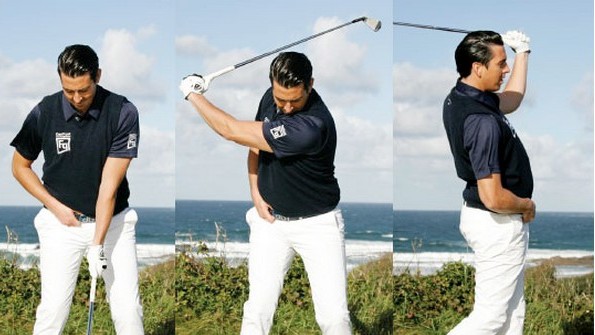Every golfer has his or her own swing DNA – natural traits and tendencies defining balance, rotation and plane which combine to determine the nature of impact.
There are many common denominators that we can identify in good players’ DNA which enable them to make (and repeat!) a powerful, efficient and dynamic action. My style as a coach is to offer simplistic methods of deep practice that enable a golfer to feel and understand effective movements in the swing. If a player can ‘feel’ a new movement 10 times in a row then the chances of them diluting them in practice are slim. Using drills that give constant reminders allows for repetition to be performed at a high level and therefore your development as a player is more effective. The drills featured in this article will help you to balance out the natural traits in your swing DNA and give you a few of the traits of world-class ball strikers. Rather than try to change your swing aggressively, I would suggest that you simply use a 10:1 practice ratio – 10 rehearsal drills to one real shot. Doing that allows you to focus intensively on your movement so that the new feeling works seamlessly into your own natural move without your brain being cluttered with complicated swing thoughts.
By Dan Frost
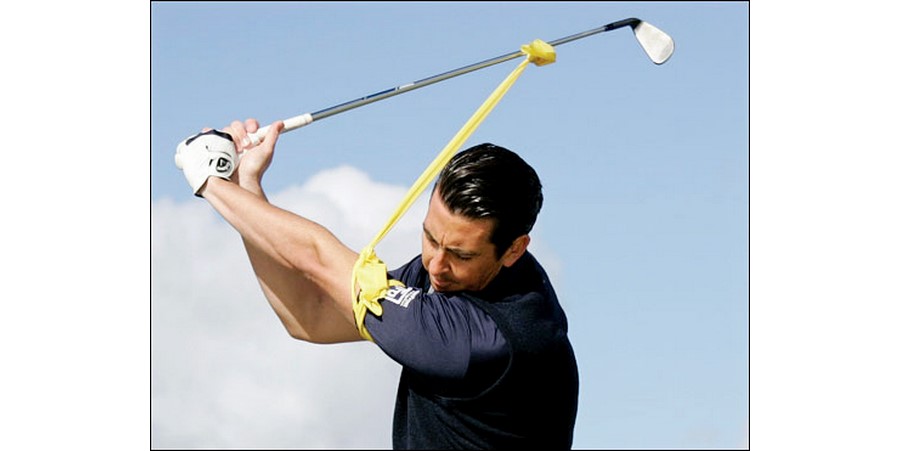
Notice that the club does not quite reach parallel although the shoulder turn is full

This will balance out any tendency to ‘cast’ or release the club early in the downswing and activate your kinematic chain – i.e. pelvis, trunk, lead arm, then club
Feel wrist hinge & forearm rotation with the hoop drill
In order to enjoy setting the club into a loaded, on-plane position in the backswing, it is vital to implement the correct blend of wrist hinge, forearm rotation and shoulder turn around a solid lower base in your swing. This drill will help you.
The manner in which the left arm rotates is often an overlooked factor when it comes to the process of navigating those first few critical feet in the backswing. If the left arm is rotated correctly you have a much better chance of setting the right arm and right elbow into an efficient plane while at the same time maintaining the radius of your swing.
Mix together the left arm rotation and the relatively short journey the left shoulder takes to arrive at a position under the chin and you will enjoy a great relationship between your arms and torso, which in turn will help you to experience the correct chain reaction (kinematic sequence) in the downswing.
My hoop drill (using a Pilate’s ring that you can buy in a sports store) allows you to feel the correct sequence and the sensations involved with ‘set’, transition and shaft control.
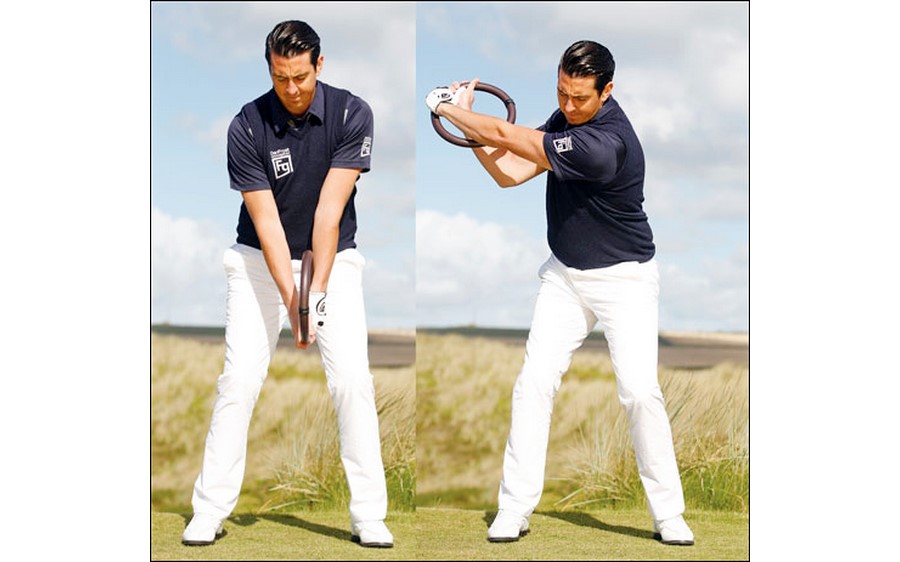
(Right) Feel the resistance in the right thigh as you rotate and set the wrists
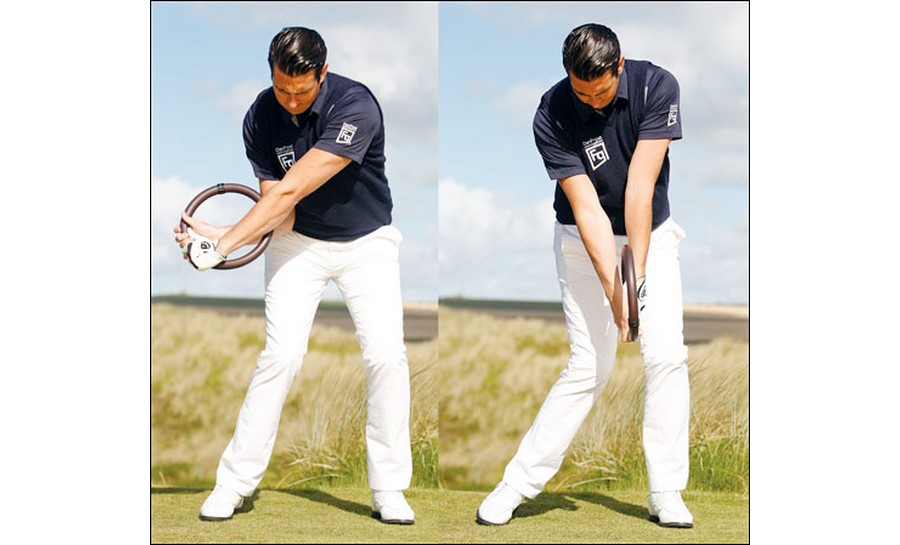
Follow these four steps to master it…
Step 1: You can establish a ‘ready’, athletic and balanced set-up position by tipping forward from the hip and ensuring that your weight is evenly distributed 50/50 between both feet (and in the middle of your feet). From here, grip the hoop with both hands, making sure that it rests on the inside of your left forearm – representing the correct forward shaft lean you should have with a club in your hands at address.
Step 2: Focus on maintaining the connection (between left forearm and hoop) you had at address as you start to rotate your left shoulder under the chin. Notice how the correct left arm rotation has encouraged the right arm fold (i.e. ‘set’).
Step 3: Start your downswing by moving your weight from your right heel to your left toe whilst maintaining left arm contact with the hoop. This will allow you to feel and retain the stored energy as the lower half moves back to impact.
(Notice how quiet the left shoulder is in transition – as per the drill on the opening spread, a good thought is to slow the left shoulder for a split-second as you start down.)
Step 4: Repetition is the key ingraining all of the feelings associated with this drill. I suggest making 10 movements with the hoop and then picking up your 7-iron and making the same swing. The feelings should linger. By practising this way you will be able to keep some of your natural swing rhythm and balance (your own swing DNA). Think about your leg action…
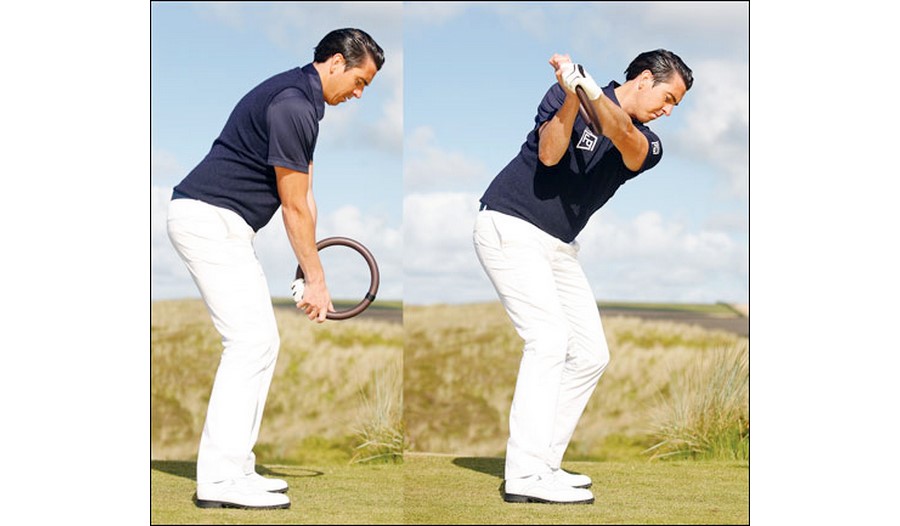
(Right) Rotation of the left forearm encourages the right arm to fold
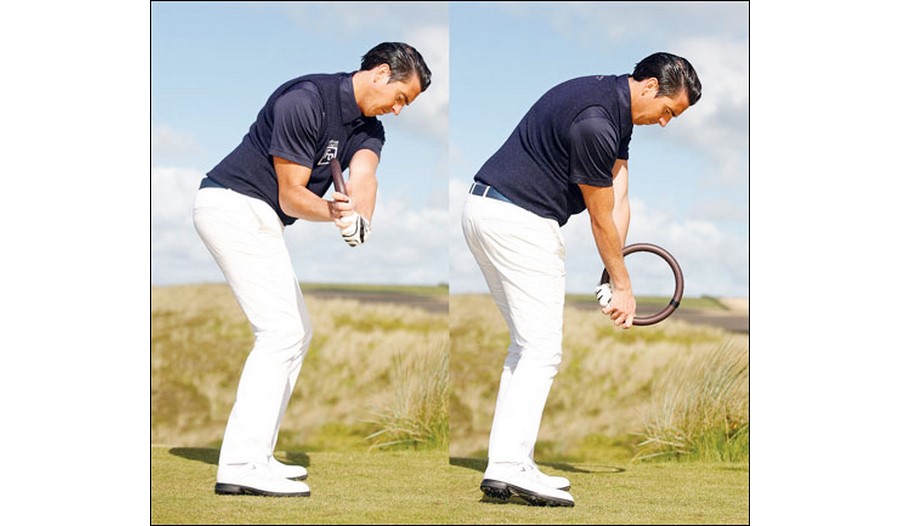
The direction of your leg drive has a massive effect on your balance in the golf swing and your spine angle through impact. Nearly all of the world’s best players lose height as they move down into impact, whereas amateurs tend to lose height in the backswing and then gain height as they glance through impact.
To get the right sensation, rehearse swings inside two canes set out like tramlines (as you see in the below). The key to this drill is to make sure that the left knee stays inside the canes on the backswing and then the right knee drives inside the canes on the downswing. These moves will limit the variables and create a good spine angle throughout the rotation.
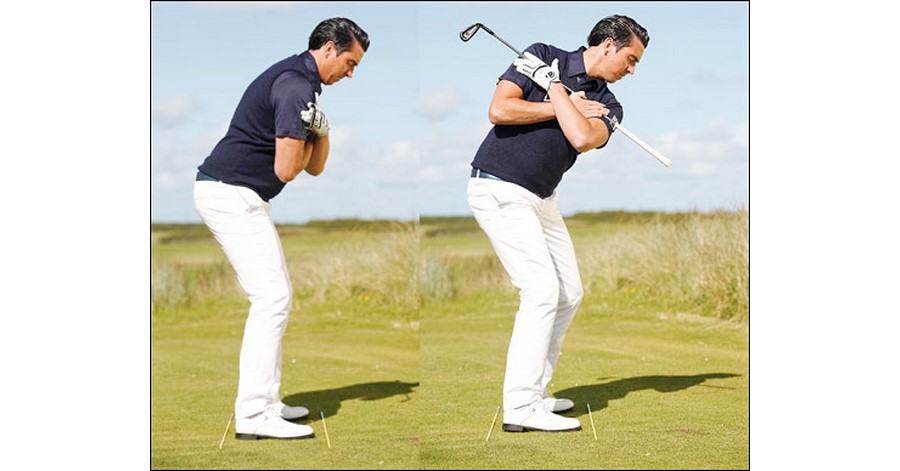
(Right) The key is to make sure that your left knee remains inside the outer cane as you complete your backswing pivot – let it ease gently across towards the braced right knee as you coil your body
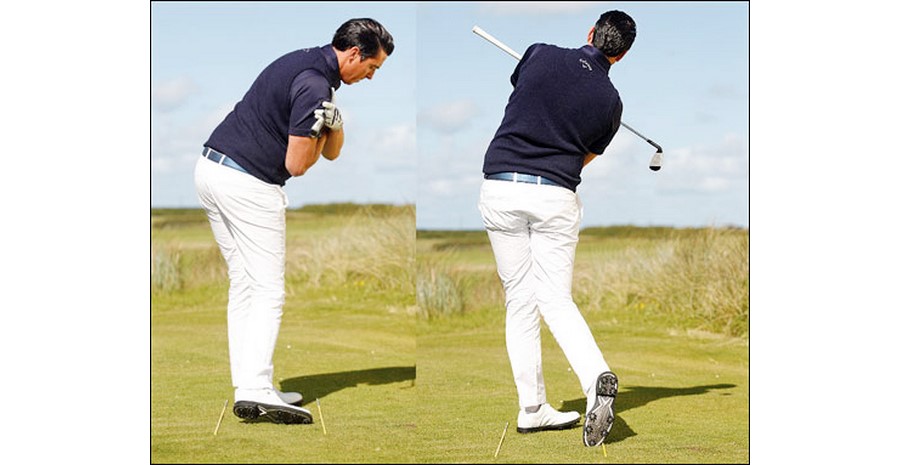
(Right) See if you can get the right knee to gently kiss the left in the finish – that’s a good indication the legs have worked well throughout
Work those hips for a better sequence of motion
As a warm-up exercise before you tee off, or simply to get some motion going before you hit balls on the range, swinging a club with your right hand only is a great way to improve the overall ‘sequencing’ of motion.
Generally speaking, when a golfer does this for the first time, what you tend to see is the lower half of the body remains static, and the overall swing lacks coordination. To get around that problem, and to help ingrain the feeling of the correct hip and low body motion, grab your right hip pocket with your left hand. Once you are in your set-up position, the key then is to focus on the role of your hips and your lower body action as you rotate into the backswing and then unwind through to a finish. I want you to feel the way the right knee, right hip and right arm all work together; pull on your right hip with your left hand to re-rotate your hips toward the target and enjoy the sensation of clearing your body and releasing the right arm and the club. When you apply both hands back to the grip you will feel a much improved sequence and balance through impact.
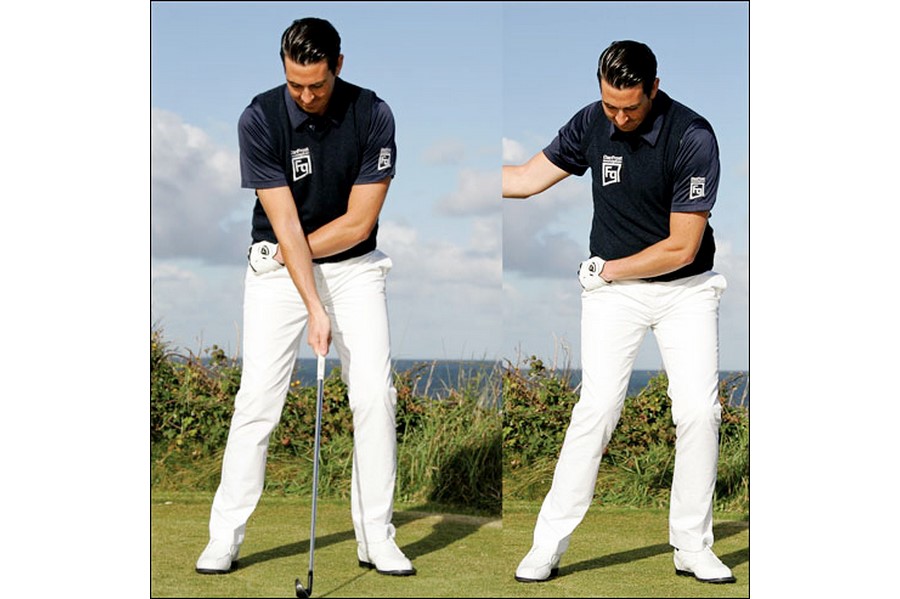
(Right) Pull on your right hip to initiate the move into the downswing…
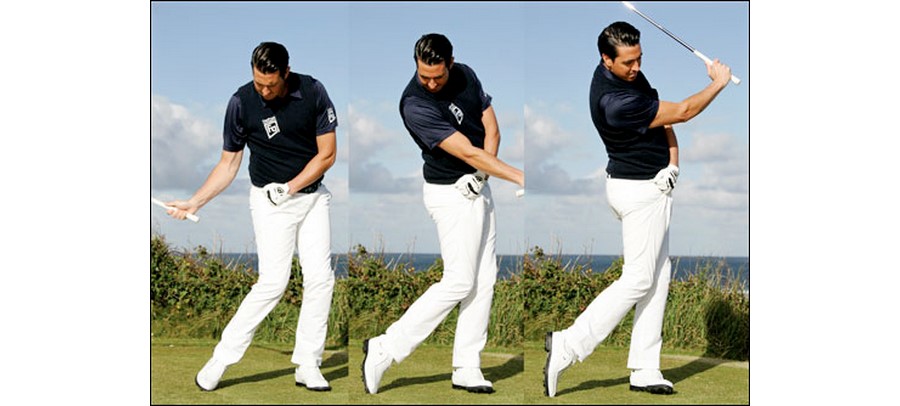
(Centre) Right foot is pulled up onto the toe, right knee works towards the left and hips face the target– a dynamic leg action that determines the rhythm of the swing
(Right) Maintain that pressure on the right hip pocket all the way through to the finish
Balance your swing, left-hand only
It’s important that you balance out your swing on either side, and not only will this left-hand-only drill complement the right-hand drill, it also helps you to train the left side for impact and quieten any tendency to over-use the wrists in an attempt to add loft and scoop the ball into the air. This drill gives you a great feeling of the dog wagging the tail (i.e. body leading the arms). It will not only give you better sequence, but also a lower, more penetrating ball flight. For every set of reps you complete with the right-hand drill, balance it with the same number of left-hand-only swings.
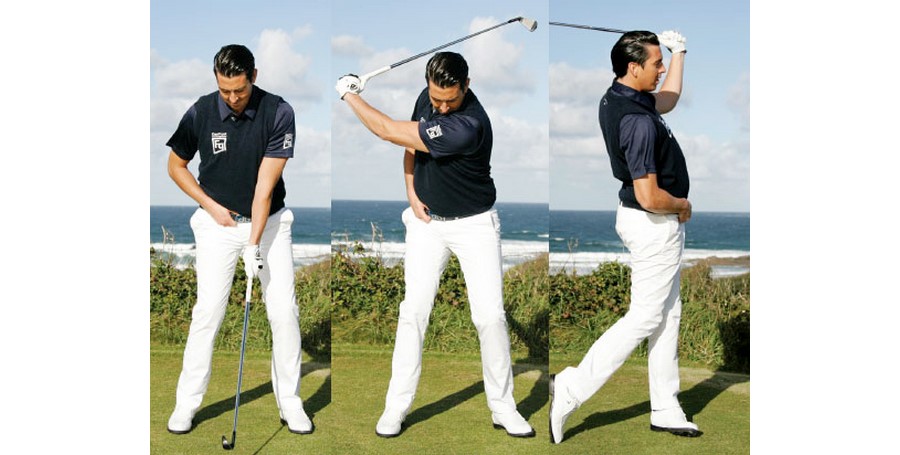
Watchface drill helps you to blend arm-swing with body rotation
One of the most common problems many amateur golfers struggle with is swinging the club on way too steep and too narrow a plane approaching impact – often the result of the classic ‘over the top’ fault that leads to all manner of pulled and sliced shots and a severe loss of distance.
At the root of the problem is a tendency to spin out of the shot with the upper body and throw the right arm and shoulder forward at the start of the downswing, which leads to a steep angle of attack on the ball. In other words, they fail to give themselves the room and the time to shallow their swing via a smooth transition into the downswing. The logical sequence of motion is lost and ball striking is erratic, at best.
So here’s a way to remedy that situation. The easiest way to establish a simple, efficient arc to your swing is to tee the ball up and focus your attention on your watch face (assuming you wear one!).
Tee it high, and make it fly!
Teeing the ball relatively high (here I’m using a 7-iron) makes it all the more inviting to clip off the peg, and with regular practise you will find that you trust your swing and collect the ball on the way through, rather than chopping down on it too steeply. (The higher you tee it, the more any tendency to chop down steeply will be revealed, as you will make contact with the tee before the ball!). Hit a dozen shots repeating this drill; with less pressure on you to get the ball airborne, you will shallow out the path of your swing and enjoy striking the ball more solidly and more consistently.
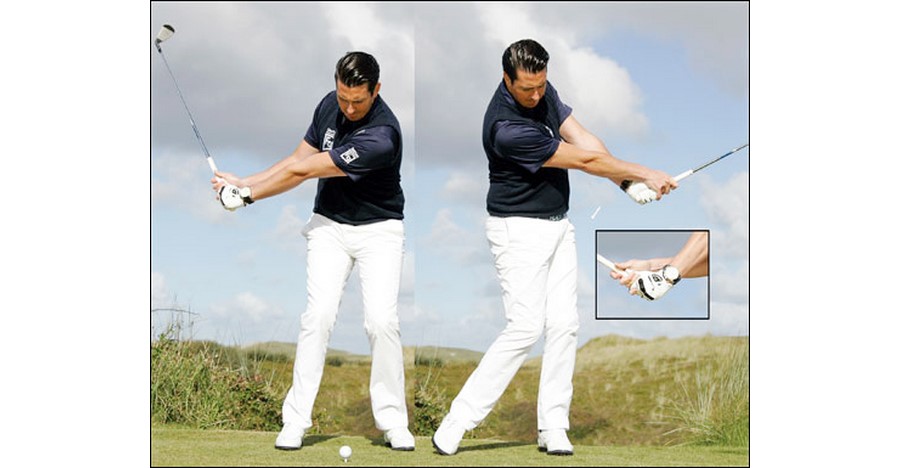
(Right) Crossover of the wrists is vital to a full release of the club and efficient delivery of speed. Rotation of left wrist and forearm into the followthrough sees the watch face look behind you
Focus on the watch face
Where does the watch face come in? Well, it’s simple: the key is to let your watch face gently rotate in a clockwise direction as you swing the club away from the ball – in so doing you will find that your left arm rotates and swings nicely across your chest, while the toe of the club works up, maintaining a neutral face angle in the backswing. Your arms and body are now working nicely in concert with the rotation of your torso in the backswing – and the real key to this drill is that a mirror image of that move is seen in the follow-through. The watch face and left arm this time rotate counter clockwise while the toe of the club again points up to the sky. One more point: notice how my ankles are firm in the backswing and soft in the through-swing.
Originally published in 2014
